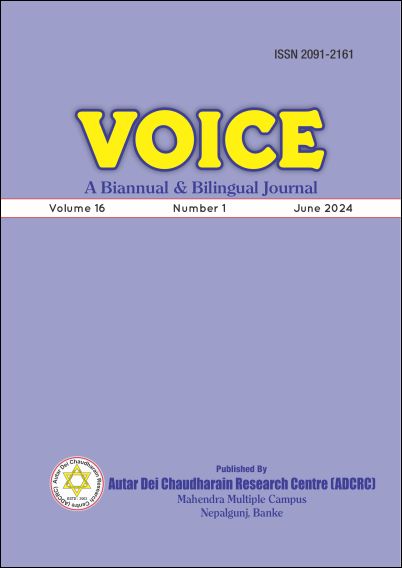Partition, Violence, Displacement and Trauma in Khushwant Singh's 'Train to Pakistan'
DOI:
https://doi.org/10.3126/voice.v16i1.67421Keywords:
Trauma, Harmony, Partition, Displacement, ViolenceAbstract
Partition of British India is an unforgettable painful experience for many people in India today. In 1947 the British government divided India into two halves: India and Pakistan before leaving India. It caused violence, separation, and displacement among people living in the contemporary harmonious community of Hindu, Muslim, Shikh, and Christian in India. It further caused traumatic feelings among them. In this context the paper attempts to study the separation, dismemberment, displacement of Muslims to Pakistan; and traumatic feelings among the people of 'Mano Majra' through the textual analysis of Khushwant Singh's novel 'Train to Pakistan'. 'Mano Majra' was a peaceful remote village with perfect harmony among Hindu, Sikh, Muslim, and Pseudo-Christian people living together on the bank of the Sutlej River, Punjab in India. Imam Baksh, Bhai Meet Singh, Lala Ram Lal, and other villagers were living in co-operation in 'Mano Majra' before the India-Pakistan partition. It is the setting of Khushwant Singh's novel 'Train to Pakistan'. Hukum Chanda (Magistrate), Sub Inspector, Haseena Begam, Juggut Singh, Nooran, Malli, and Iqbal are other major characters in the novel. The novel shows the completely harmonious society in the village before partition. However, the partition caused the complete division and disruption of harmonious societies in India including 'Mano Majra' leading to violence, displacement, separation, and trauma.
Downloads
Downloads
Published
How to Cite
Issue
Section
License
Copyright (c) 2024 The Author(s)

This work is licensed under a Creative Commons Attribution-NonCommercial 4.0 International License.
CC BY-NC: This license allows reusers to distribute, remix, adapt, and build upon the material in any medium or format for noncommercial purposes only, and only so long as attribution is given to the creator.




